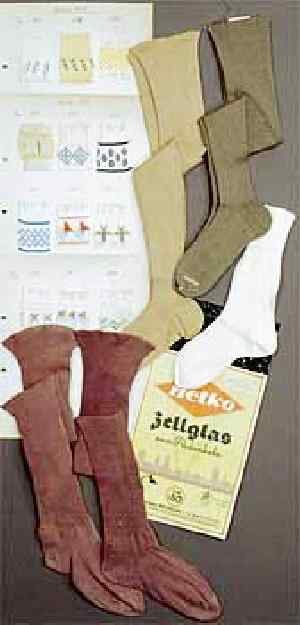
German Product Packaging: Netko Long Stockings (Germany, 1939 or '40)

Figure 1.--We note some long stockings and the packages marketed in Germany about 1939 or '40. The company appears to be Netko and the brand appears to be Jeliglas. The stockings are offered in browns and dull greens. There is also a pair of shorter-length white socks. Long stockings wew worn by boys and girls. Images like this are helpful because they give ome idea as to the actual colors of the stockings. Image courtesy of the German Hosiery Museum.
|
We note some long stockings and the packages marketed in Germany about 1939 or '40. The company appears to be Netko and the brand appears to be Jeliglas. The stockings are offered in browns and dull greens. There is also a pair of shorter-length white socks. Long stockings wew worn by boys and girls. Images like this are helpful because they give ome idea as to the actual colors of the stockings. Most period photographs are black and white.
Long Stockings
Here is some product packaging during 1939-40 for childrens' long stockings. These were commonly worn by boys with short pants during the 1930s, 1940s and 1950s in Germany, especially during the colder months even though the Nazis discouraged their use as lacking in masculinity. But they were worn in rural areas nevertheless because mothers
insisted on their propriety and wanted their boys' knees covered because of the chilly climate. After the war they became standard school boys' dress and lasted into the 1960s in some areas, especially in East Germany.
Material
In the 1920s most German children wore wool long stockings, but in the 1930s cotton stockings became more popular because they were less itchy and much more comfortable on the thighs. When war came in 1939, cotton, which had to be imported, became quite scarce in Germany, so the manufacturers resorted to various substitutes such as "acetate celanese" and "copper celanese". Rayon was also beginning to be used in the knitting of stockings in Europe as in America. The brand name shown here is "Netco" and the fabric advertised
is "Zellglass"--obviously synthetic since cotton was not available. Zellglass was one of several polyester materials developed at the time.
Colors
This display advertisement also illustrates the standard colors of boys' and girls' long
stockings in the Third Reich and afterwards--beige, grey-olive, and dark
brown. Black, which had been common in the 1920s, had almost disappeared
except for very formal occasions such as church services. Note that the white socks shown are short socks, looking to be ankle socks.
Length
Note too that the stockings are knit very long so as to come up extra high on the leg. This is because they were usually worn with very short shorts or lederhosen. (See the
photo of three brothers, the oldest of whom wears dark long stockings with his lederhosen.) Girls' skirts were also getting shorter. Mothers did not want the garters to show or the upper leg to be exposed to air since underpants were typically rather brief in this period.
Stocking Supporters
Most boys wore these stockings with a Leibchen--a bodice which buttoned either
in front or in back and had four elastic garters with metal clasps attached--
normally two for each stocking placed in front and in back. Some older boys
wore garter belts with hose supporters in a style similar to their mothers but
without the feminine adornments of ladies garter belts. Girls often wore
these in pink, while boys for obvious reasons preferred grey or white
elastic. Note that the ad also shows three-quarter length white socks, worn
more commonly by younger children or girls.
Written Material
I'm not sure what the written material in the image here are (figure 1). A reader writes, "I'm also puzzled also about the written background in the stocking image. But it's too small to read. I think it may have something to do with various texture
or weaving patterns in some of the Netco products. Since the stockings being advertised in the image are plain colors and not even ribbed or textured in any obvious way, I doubt that the illegible text behind is directly relevant to the stockings shown. Still, why have it there at all if this is the case? The German Hosiery Museum might be able to throw light on this problem."
HBC

Navigate the Boys' Historical Clothing catalog/magazine pages:
[Return to the Main German mail order 1930s page]
[Return to the Main German page]
[Main photo/publishing page]
[Store catalogs]
[Fashion magazines]
Navigate the Boys' Historical Clothing Web Site:
[Introduction]
[Activities]
[Biographies]
[Chronology]
[Clothing styles]
[Countries]
[Topics]
[Bibliographies]
[Contributions]
[FAQs]
[Glossaries]
[Satellite sites]
[Tools]
[Boys' Clothing Home]
Navigate the Boys' Historical Clothing Web Site:
[Overcoats]
[Short pants suits]
[Sailor suits]
[Sailor hats]
[Buster Brown suits]
[Eton suits]
[Rompers]
[Tunics]
[Kneesocks]
[Long stockings]
Created: January 16, 2003
Last updated: 12:27 AM 3/4/2006



